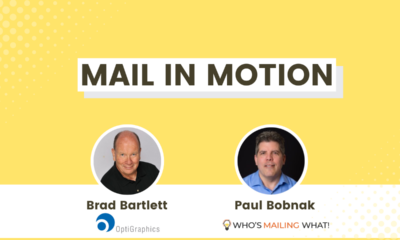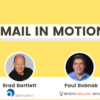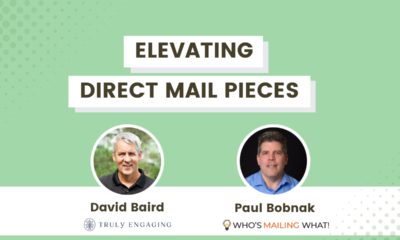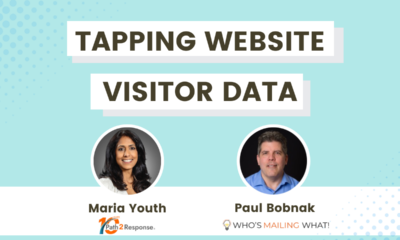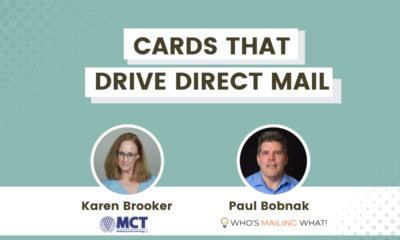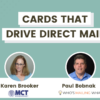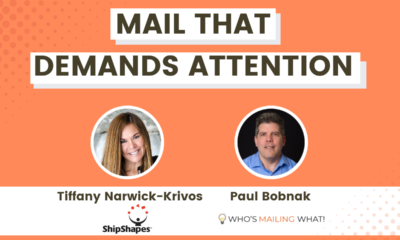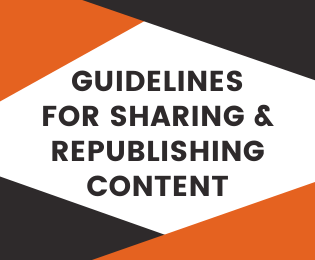MEET THE MAILERS
Meet the Mailers: Successful Data Modeling
In this episode, I talked with AMP about how companies can focus on reducing waste and increasing results in their direct mail.
In this episode, I talked with Steve Godwin, President of Analytic Marketing Partners (AMP). Analytic Marketing Partners works with marketers to identify their best targets by evaluating hundreds of data points on a market-by-market basis.
Our talk dealt with how companies can focus on reducing waste and increasing results in their direct mail.
Steve emphasized how his company helps look at data on more granular basis to help make marketing decisions:
Instead of just building one model, like a lot of companies will do, we can get you a very localized, unique view of what’s happening at the consumer level.
 Steve Godwin President
Steve Godwin President
Analytic Marketing Partners (AMP)
Among the topics we covered:
- His background in direct mail marketing
- The role of modeling in guiding your marketing strategy
- USPS’s best tool to maximize your data
- How the 4 Ps (what are they?) can save marketers money
- Direct mail’s value proposition for an important demographic (find out which one)
Here are some questions and answers (edited for clarity and space):
- Can you explain a little bit more about micro modeling? What is it and how does it help marketers do their jobs better?
Micro Modeling is actually our registered trademark tool that we’ve developed through the years. We’ve done a lot of manual modeling. We tried to automate some of those processes so that we could expedite things, so instead of getting something in two months, we might get it to you in a week or two so that you can make decisions this month instead of next quarter.
So that’s really, really important, but it layers a variety of data sets. We may be looking at things like demographics, behavioral lifestyles, geography, spatial data, socioeconomics. And the unique proposition of that is we can model to every physical location, every market, every region – whatever makes sense from your data.
Instead of just building one model, like a lot of companies will do, we can get you a very localized, unique view of what’s happening at the consumer level.
- How do you work with clients to understand their data – about who their best customers or prospects are and where opportunities lie?
So all customers are, you mentioned best customers, we will typically append hundreds of data variables to a data set that a client hands to us. And one of the things you want to understand is what these folks look like, whether that’s your best customers or a segment of customers, something like that.
But secondly, we’ll take a random sample population so that we can understand how your customers differ or what makes them unique within that population that allows you to go through and find out where market penetrations are significant.
Those are your opportunities. It can really demonstrate what you need to go out with as far as the marketing message, the images you use, and what products and/or services are going to be best-suited for your best opportunity.
- What types of tools should marketers be using, say, from USPS or other sources to optimize their data?
NCOA (National Change of Address) is really important. You know, when I had 27 million customers put under my realm of opportunity there at my first company, I think that was really eye-telling.
They started building databases back in the sixties. When NCOA came along, this and stuff had never been cleaned. It was a disaster. But I would recommend using a vendor that may have 4-6 years of NCOA versus just the standard 18 months. 18 months will get you through automation postage discounts, but if you’re trying to clean your data and you want to really know what’s going on…you know, we’ve done work for casinos in the past because they had people that were spending hundreds of thousands of dollars with them and they couldn’t find them. We would go through and not just run NCOA once, but anybody that moved once we may run them through NCOA several times to do that.
Behind that, deduplication is really important in your customer database. Sometimes we’ll find 6 or 10 occurrences of the same customer. Once we get all the data hygiene done, it’s a great opportunity to consolidate those people and get a single view of who that customer actually is with you. They may have been with you a long time, but you may have created multiple copies of that customer at different addresses.
- What kind of mistakes do you think marketers make with their direct mail?
Well, there are several things … but analytics is so important. People a lot of times don’t analyze who they’re going to mail to, so they don’t create any segments or anything. They send the whole audience the same message. And, you know, you can change offers, messages, images, all of these things, if you do some analytics on the front end.
As I was talking with a client out of DC yesterday … this was all they wanted to talk about for somebody that’s mailing about 5 million pieces a month. And they just said, “You know, we want to start setting up tests and controls using your segmentation so that we can understand what’s working and what’s not in that space”.
Secondly, I would say there are still a lot of marketers that do not have a good capture mechanism for a response. That is so critical to success, I can’t emphasize that enough. You need to capture name and address. If you can’t capture name and address, make sure you’re capturing an email, an IP address, something like that, that we can reverse append with name and address and make sure that we’re understanding truly how this campaign is working.
- We know that postage and paper costs put pressure on marketers to save money on mail. What are some good ways for them to keep costs under control?
So again, analyzing results is really important because you need to figure out what’s working, what’s not, don’t waste the money on what’s not going to be there.
And frankly, that’s where we counsel a lot of people that use digital. If these are still opportunities, but direct mail, you can’t get a return on investment – send them an email or something, but don’t spend the direct mail money on that. We’ve got a larger audience over here, we can send direct mail to, we want to focus on that.
Seasoned printers, salespeople will usually do a great job recommending paper sizes, and paper weights to maximize your marketing opportunity there, whether that’s sheetfed or webfed, those things become really important. So you need to find a good partner there. Maximize the mail piece size; you want as much real estate as you can get there to make sure that you’re getting the most value you can for your dollar.
Here is our conversation. We’ve added timecodes for your convenience.
Thanks again, Steve, for an interesting and informative chat! To learn more about Analytic Marketing Partners, visit AMPanalytic.com.
Your comments and ideas are very important to us in making your Who’s Mailing What! experience even better for you. Through these engaging and informative talks, we hope you’ll take away practical tips, insights, and stories to inspire and build your own success.
If you have any feedback — or are interested in sharing your expertise with our wide and diverse audience — please reach out to me. I’d love to hear from you!







